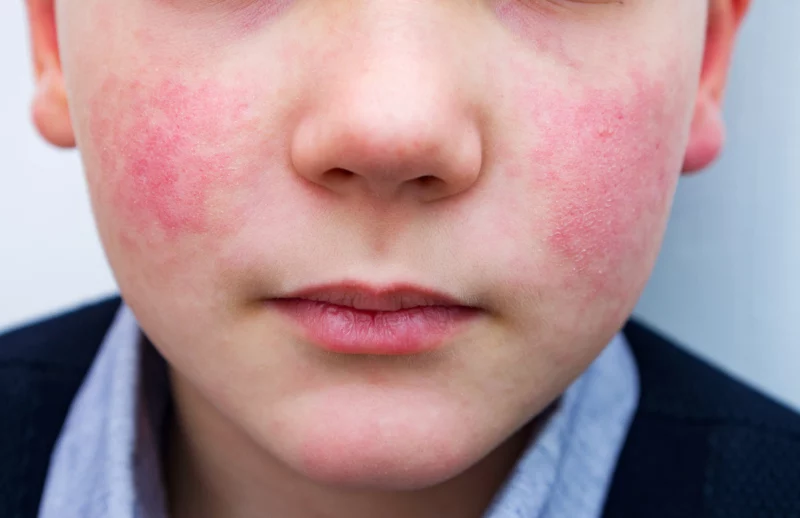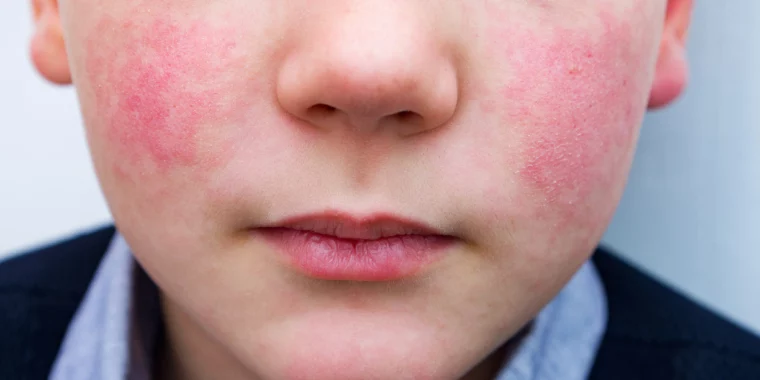
A common seasonal respiratory virus that typically infects school-age children is causing an unusually large spike in cases in Europe and the United States this summer. The surge in transmission poses a significant danger to certain vulnerable populations, including pregnant people, according to a health alert issued Tuesday by the Centers for Disease Control and Prevention.
The virus is parvovirus B19, also called B19V, which spreads via respiratory droplets and typically causes a mild, two-phase illness in children. The first phase is characterized by flu-like symptoms, including fever, headache, malaise, muscle aches, cough, sore throat and joint pain. In the second phase, a characteristic “slapped cheek” rash develops, which is also called fifth disease or erythema infectious. By age 20, about 50 percent of people have been infected and have antibodies that can help fight off reinfection. And by age 40, that figure rises to 70 percent.
But for people with weakened immune systems, who are pregnant or have certain conditions, such as sickle cell anemia, the virus can cause serious complications, such as severe anemia, myocarditis, hepatitis or encephalitis. During pregnancy, the virus can infect the fetus and cause dangerous complications and miscarriage.
Normally, the virus spreads without much warning and rarely causes serious illness. But in recent months, B19V has risen above the din of seasonal viruses. Late last year, for example, health researchers in Israel reported the country’s largest and longest-lasting B19V outbreak to date, with the number of cases nine times higher than between 2020 and 2022, and 6.6 times higher than in previous years. Pregnant people were at relatively increased risk during the outbreak.
International revival
In June, researchers in Denmark reported a spike in cases earlier this year, marking the highest infection rate in the past 10 years, 3.5 times higher than the next-highest peak in 2017. But Denmark is not alone. Also in June, the European Centre for Disease Prevention and Control reported that 14 European countries had seen unusually large increases in B19V infections.
According to the U.S. CDC, the peak appeared to arrive in North America in June, although data is limited. Given its generally mild presentation, B19V is not a nationally reportable infection in the U.S., meaning cases are not tracked. However, the CDC does passively collect data on the virus.
For example, commercial labs have reported increases in test positivity, and the percentage of people with IgM antibodies, an indicator of recent infection, has increased among all ages from less than 3 percent between 2022 and 2024 to 10 percent in June. Children ages 5 to 9 saw the largest increase, from 15 percent between 2022 and 2024 to 40 percent in June 2024. Among plasma donors, the prevalence of pooled samples with a threshold of B19V DNA increased from 1.5 percent in December 2023 to 20 percent in June 2024. The CDC also said it has received anecdotal reports of increases in B19V cases in pregnant patients.
The CDC is urging clinicians to be more aware of the potential for B19V infection. For pregnant people and others at high risk, the CDC recommends taking precautions such as wearing a mask and practicing vigilant hand hygiene. This is especially important for high-risk people in work settings with close contact with children, such as schools and daycare centers, the CDC said.
It’s unclear what’s driving B19V, but researchers have noted that B19V tends to have small peaks every three to four years. With the global introduction of SARS-CoV-2 in late 2019, many seasonal and cyclical patterns of infectious diseases were disrupted, leading to unusual dips and spikes in transmission. B19V transmission may also have been affected.

